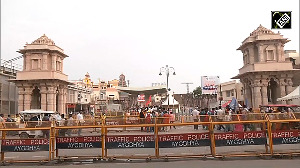The Late Biju Patnaik's dream of building Asia's biggest steel hub at Kalinga Nagar in Orissa may have put him in the league of visionaries, but the recent clash between the police and tribals there has cast its shadow on his vision.
Now even the industry is questioning the very concept of the cluster approach for mega projects.
The clash has exposed the dreaded truth about 'stand all or fall all' in a cluster approach.
"This incident has shown that if anything untoward happens in one industry, it immediately affects others. This will make them insecure and hamper their work," says Anup Parija, vice-president, VIA Industries, which is building a 1.5 million tonne plant in the area.
Of the 43 MoUs signed by the Orissa government for setting up steel plants (with a combined capacity of 54 million tonnes and proposed investment of Rs 1,18,000 crore -- Rs 1,180 billion), seven are slated to be located in the Kalinga Nagar industrial complex envisaging a combined capacity of 13 million tonnes and an investment of Rs 27,000 crore (Rs 270 billion). Add to this the two existing plants -- the 1 million tonne steel capacity each of Nilachal Ispat Nigam and Mid East Integrated Steel.
What is worrying industry now is the master plan of the Kalinga Nagar Industrial Complex, which envisages provision of common facilities for water supply, power and a merry-go-round railway carriage system.
"If for some reason trouble erupts in one plant and some of these supply lines are disrupted, then all the industries in the complex will come to stand still," says Parija.
Rajdeep Mohanty, a senior executive of Jindal Stainless feels that it is better to have the industries spread over an area so that not only the magnitude of human displacement remains manageable but also the impact of any industrial violence can be localised.
Jindal Stainless has already felt the pinch with about 50 per cent of unskilled workers, most of whom are tribals, staying away from work following the recent violence.
Even otherwise, the pressure on infrastructure in a cluster approach will be enormous as production of one tonne steel requires transportation of four tonnes of material, besides the use of water and power, says SK Sarna, managing director, Nilachal Ispat Nigam.
But for the moment, the security has become the main issue for the industries in the area as they strive to insulate their units from the trouble.
"What is required, more than security, for the smooth functioning of the industry is an amicable settlement," says Parija.
Kalinga Nagar has one police station headed by an inspector-in-charge with two platoons of police deployed for maintaining law and order round-the-year.
| POINTS OF CONCERN |







 © 2025
© 2025